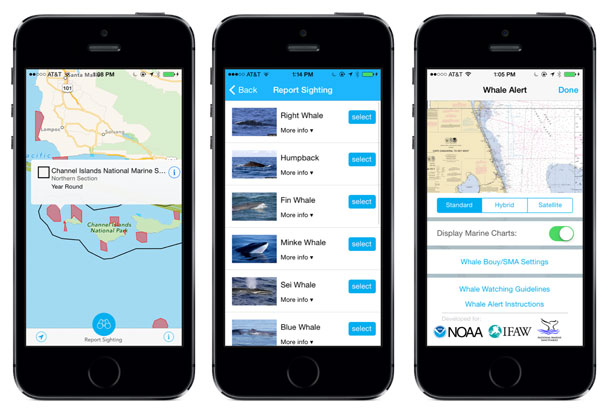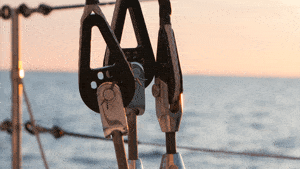Mariners and the public on the U.S. West Coast can now use an iPad™ and iPhone™ to help decrease the risk of injury or death to whales from ship strikes.
Whale Alert a free mobile application originally developed in 2012 to help protect endangered right whales on the East Coast, has been updated with new features to provide mariners in the Pacific with the most current information available about whale movements and conservation initiatives.
The app uses GPS, Automatic Identification System, Internet and NOAA nautical charts to provide mariners with a single source of information about whale locations and conservation measures that are active in their immediate vicinity. New features include information about California Marine Protected Areas, PORTS® (Physical Oceanographic Real-Time System) tide and weather data and the ability for the public to report whale sightings to databases that NOAA and whale biologists use to map whale habitats and migration patterns.
“Whales are important both ecologically and economically, but they continue to face a variety of threats including ship strikes,” said Michael Carver, deputy superintendent of Cordell Bank National Marine Sanctuary. “Whale Alert allows citizens to provide data scientists can use to inform management and better protect whale populations.”
Slow-moving whales are highly vulnerable to ship strikes, since many of their feeding and migration areas overlap with shipping lanes. In 2007, four blue whales were killed by confirmed or likely ship strike in and around the Santa Barbara Channel. NOAA Fisheries declared this an Unusual Mortality Event. In 2010, five whales (two blue, one humpback and two fin whales) were killed by confirmed or likely ship strikes in the San Francisco area and elsewhere along the north-central California coast.
“Ship strikes kill and injure large whales. Whale Alert will help mariners and all of us protect these magnificent creatures,” said Patrick Ramage, Whale Program director at the International Fund for Animal Welfare, one of the lead collaborators on Whale Alert.
Whale Alert has been developed by a collaboration of government agencies, academic institutions, non-profit conservation groups and private sector industries, led by NOAA’s Office of National Marine Sanctuaries. Collaborating organizations include Bioacoustics Research Program at Cornell University, Cape Cod National Seashore, Center for Coastal and Ocean Mapping at the University of New Hampshire, Conserve I.O., Excelerate Energy, EOM Offshore, International Fund for Animal Welfare, Massachusetts Port Authority, NOAA Fisheries, National Park Service, Point Blue Conservation Science, U.S. Coast Guard and the Woods Hole Oceanographic Institution, as well as shipping industry representatives.
Whale Alert data collected by citizen science and scientists are currently available online at the Whale Alert – West Coast website. “More is usually better when it comes to data,” said Jaime Jahncke, Point Blue Conservation Science lead on the project. “Whale Alert allows us to crowd source data collection, so that as scientists we have more information available to help protect whales from ships.”
Whale Alert can be downloaded free of charge from Apple’s App Store. More information on Whale Alert and the groups responsible for its development can be found at www.whalealert.org.
Courtesy of sanctuaries.noaa.gov












